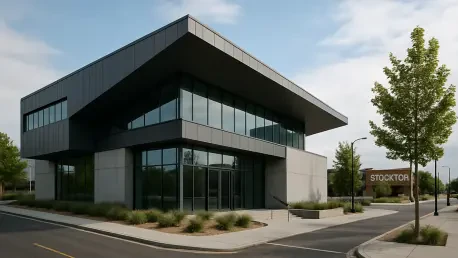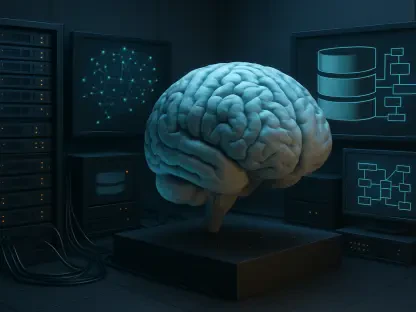Imagine a world where artificial intelligence processes data so swiftly that smart factories adjust production in real-time, autonomous vehicles navigate with split-second precision, and healthcare systems predict patient needs before symptoms even appear, transforming industries overnight. This vision is becoming reality with a groundbreaking $130 million investment in a neural edge data center in Stockton-on-Tees, positioning the UK as a frontrunner in AI infrastructure. Located at Preston Farm Industrial Estate, this facility, spearheaded by Latos Data Centres, has secured full planning approval and is on track to be operational by early 2027. Spanning 1,750 square meters, it will harness cutting-edge Nvidia Blackwell GPU systems to enable millisecond-speed AI inference and localized data processing. As the first of a planned 40-site network across the UK, this hub marks a transformative step toward decentralized, high-performance computing. The implications for industries prioritizing latency, security, and sovereignty are profound, setting the stage for a new era of technological advancement.
Pioneering Neural Edge Technology
The concept of neural edge data centers represents a significant departure from traditional cloud-based systems, focusing on placing AI computing power directly at the network’s edge. Unlike conventional setups where data must travel long distances to centralized servers, this approach drastically reduces latency, enabling near-instantaneous processing critical for applications like augmented reality and predictive analytics. The Stockton facility stands as a flagship for this innovation, equipped with advanced Nvidia Blackwell GPU architecture tailored for complex tasks such as large language models and computer vision. By prioritizing proximity, the center ensures that data-intensive operations are handled locally, minimizing delays and enhancing performance for UK businesses. This shift toward edge computing reflects a growing recognition of the need for responsive infrastructure that can keep pace with the demands of modern AI workloads, particularly in sectors where every millisecond counts.
Beyond the technical advancements, the neural edge model offers a blueprint for scalability and adaptability in AI infrastructure. The Stockton hub is designed to support rapid deployment and future-ready upgrades, ensuring it can evolve alongside emerging technologies. This forward-thinking approach is vital as industries increasingly rely on AI for real-time decision-making, from smart manufacturing optimizing supply chains to autonomous systems requiring split-second responses. Additionally, the facility’s emphasis on localized processing addresses critical concerns around data security by reducing the risks associated with long-distance data transfers. As the first in a nationwide rollout, this center sets a precedent for how distributed AI inference can transform operational efficiency across diverse fields. The strategic vision behind this project underscores a broader industry trend toward creating resilient, low-latency networks capable of supporting the next generation of digital innovation.
Strategic Regional Impact of Teesside
Selecting Teesside as the launch site for this neural edge hub is no coincidence, as the region offers a unique blend of industrial heritage and burgeoning technological ambition. The Tees Valley has emerged as a dynamic growth corridor for tech, energy, and engineering, bolstered by a robust startup ecosystem and the presence of the UK’s Centre for Process Innovation. These factors create fertile ground for market demand and provide access to a skilled workforce ready to support advanced AI initiatives. Latos Data Centres recognized the area’s potential to serve as a catalyst for their national expansion, leveraging local strengths in advanced manufacturing and digital infrastructure. This decision not only boosts the regional economy but also positions Teesside as a pivotal player in the UK’s AI landscape, demonstrating how strategic location choices can amplify the impact of technological investments.
Moreover, the Stockton hub’s establishment in Teesside aligns with broader goals of regional development and digital transformation. By anchoring the facility in an area with deep industrial roots, the project bridges traditional sectors with cutting-edge technology, fostering innovation in fields like energy and engineering through AI applications. The proximity to manufacturing clusters ensures that businesses can directly benefit from low-latency processing, enabling smarter, more efficient operations. This regional focus also serves as a model for future sites in cities like Manchester and Birmingham, illustrating how localized AI hubs can address specific community needs while contributing to national objectives. The synergy between Teesside’s capabilities and the neural edge center’s offerings highlights the importance of aligning technological advancements with regional strengths, creating a ripple effect of economic and innovative growth across the UK.
Building Digital Resilience for the UK
A cornerstone of the Stockton neural edge hub is its commitment to sovereign AI infrastructure, ensuring that British data remains within national borders for enhanced security and compliance. This focus on data sovereignty addresses growing concerns among government and industry leaders about the risks of relying on foreign-based cloud systems, particularly in latency-sensitive and regulated sectors. The facility’s on-premise processing capabilities provide a secure foundation for UK businesses to adopt AI without compromising speed or safety, fostering trust in digital operations. By prioritizing localized infrastructure, the project strengthens the nation’s digital resilience, offering a competitive edge in a global market where data protection and performance are paramount. This initiative reflects a strategic push to safeguard critical information while enabling rapid innovation.
Equally important is the role of this hub in positioning the UK as a leader in the AI era through a decentralized network of high-performance centers. With plans to expand to 40 locations, ensuring no business in mainland Britain is more than 50 miles from a neural edge facility, the vision is to create a robust digital backbone tailored to real-time workloads. This approach not only enhances operational efficiency but also supports sustainability by reducing the energy costs associated with long-distance data transmission. The Stockton center, as the starting point, exemplifies how targeted investments in sovereign infrastructure can address both current needs and future challenges. By building a framework for secure, localized AI processing, the project lays the groundwork for British industries to thrive in an increasingly competitive technological landscape, balancing innovation with responsibility.
Reflecting on a Transformative Milestone
Looking back, the launch of the Stockton neural edge data center stood as a defining moment in the UK’s journey toward AI-driven transformation. Construction kicked off with an ambitious 18-month timeline, marking a significant stride in redefining how industries approached latency and data security. This facility, with its cutting-edge technology and strategic location, became a beacon of what localized AI infrastructure could achieve, inspiring subsequent hubs across the nation. The emphasis on sovereign processing reshaped conversations around digital resilience, while the regional boost to Teesside highlighted the power of aligning tech investments with local strengths. As the project unfolded, it paved the way for actionable next steps, encouraging policymakers and businesses to prioritize decentralized networks. The success of this endeavor underscored the potential for similar initiatives to drive innovation, urging stakeholders to explore how edge computing could further revolutionize sectors from healthcare to manufacturing in the years that followed.









